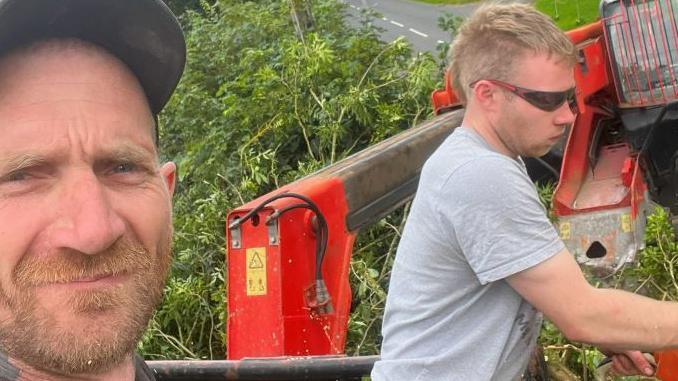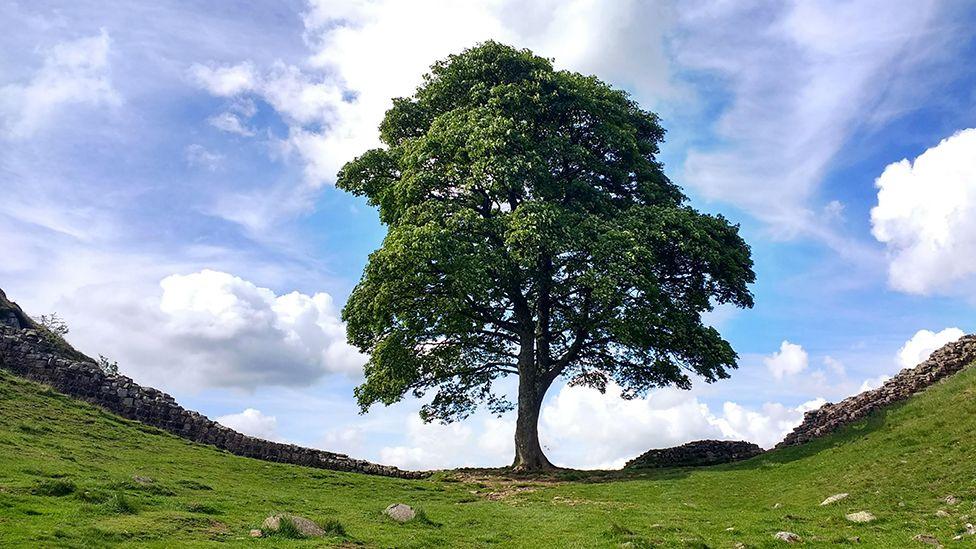Sycamore Gap tree: The story so far
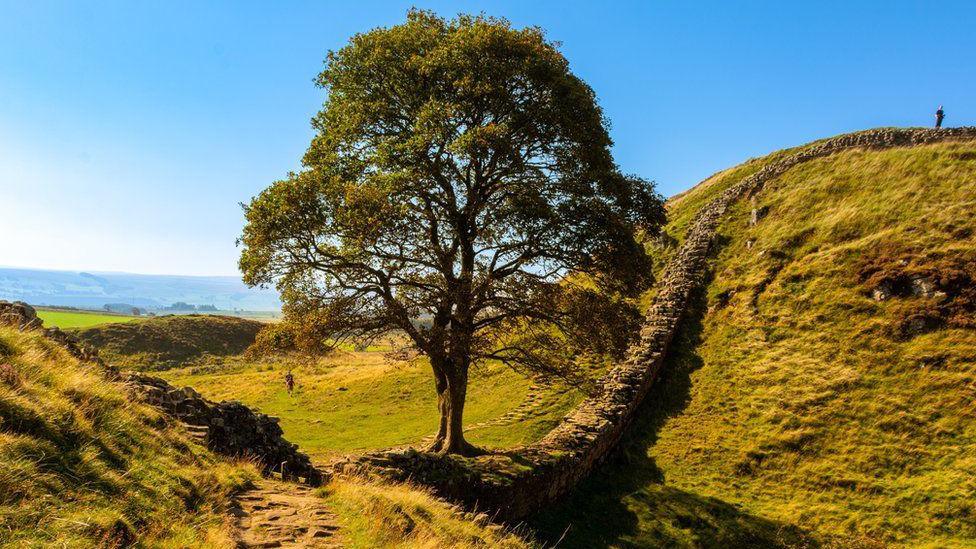
The Sycamore Gap tree was a landmark of Northumberland and northern England
- Published
Two men have been jailed for chopping down the Sycamore Gap tree, which once stood in a dip next to Hadrian's Wall in Northumberland. It was an incredibly popular landmark, what happened to it and why was it so beloved?
What was the Sycamore Gap tree?
Quite simply it was a single sycamore tree growing in a natural dip in the countryside along Hadrian's Wall, close to the village of Once Brewed.
The National Trust, which looks after the site with the Northumberland National Park Authority, said it was planted in the late 1800s by previous landowner John Clayton to be a "feature in the landscape", external.
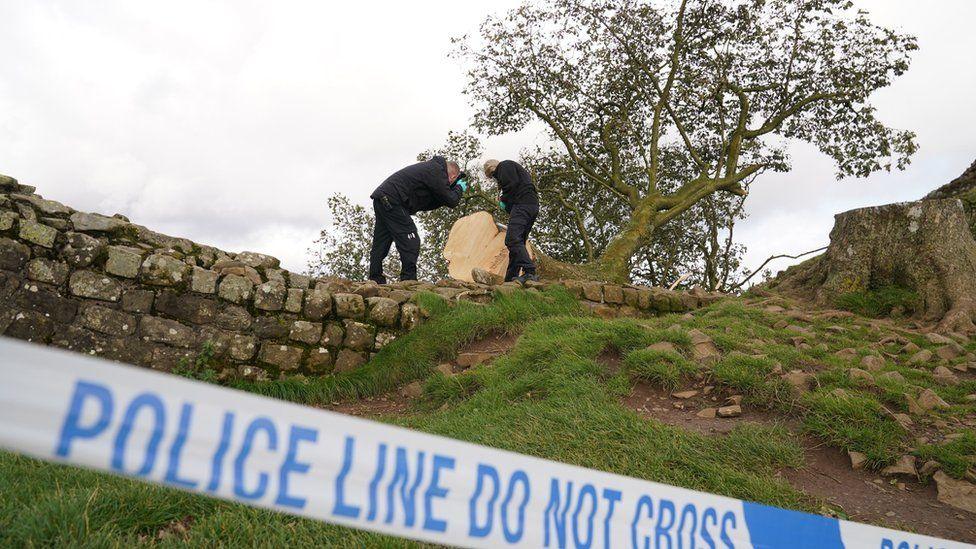
Forensic investigators examined the remains of the Sycamore Gap tree
The tree in films
While a popular spot for walkers and photographers due to its unusual setting, it became famous after featuring in the 1991 film Robin Hood: Prince of Thieves starring Kevin Costner. Afterwards, it gained the nickname the Robin Hood Tree - although in reality it was some 170 miles (273 km) from Sherwood Forest.
Dan Newman, whose character Wulf hides in the tree and is rescued by the eponymous hero, told the BBC it was the first scene he filmed on his very first day on set.
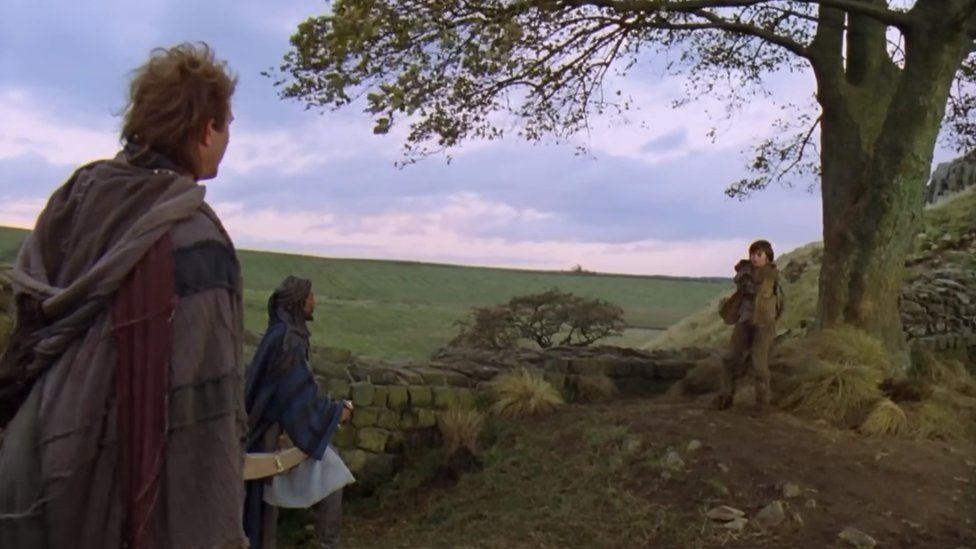
Kevin Costner, Morgan Freeman and Dan Newman at the tree in 1991's Robin Hood: Prince of Thieves
The film's director Kevin Reynolds said it was "one of the most quintessentially idyllic spots in the world".
Despite the felling he said he did not "regret" choosing to film there.
"You could say oh it got cut down because it became famous, so many people saw the movie and maybe there's some truth in that.
"But it came out of the fact that I found it so special and I wanted to share with people how special it was, and I think people did see it that way."
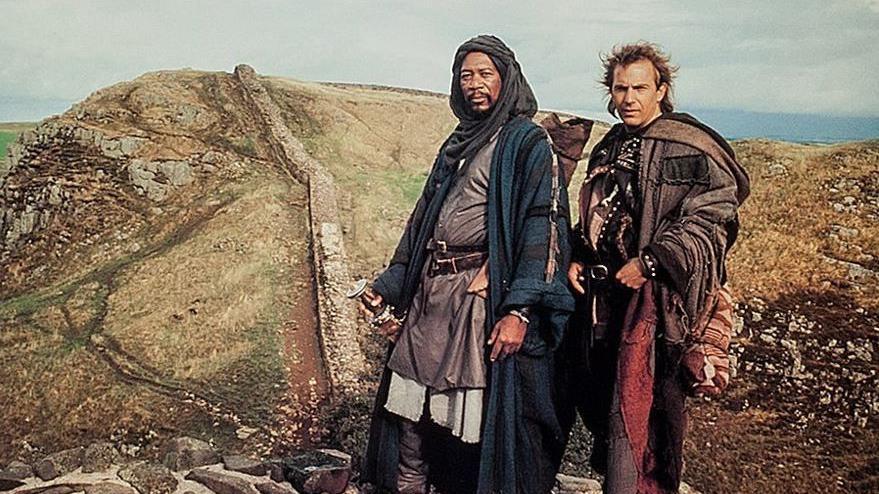
Robin Hood, Prince of Thieves which included a scene filmed at the Sycamore Gap tree starred Kevin Costner and Morgan Freeman
Mr Reynolds said he will "never return".
"I wouldn't definitely have gone back but I couldn't look at it, and I still don't want to look at it.
"I'm glad they caught the guys that did it and I hope they suffer the largest penalty allowed by the law, part of me thinks it would be just to tattoo the fallen tree on their foreheads."
More than three decades after its last starring role, and after the tree had been illegally felled, it appeared again in a major film.

Alfie Williams, Jodie Comer, Danny Boyle and Aaron Taylor-Johnson were at the premiere of 28 Years Later in London's Leicester Square
Director Danny Boyle's 28 Years Later, the sequel to 28 Days Later and 28 Weeks Later, was filmed at various locations in Northumberland and included a computer-generated image of the tree at Sycamore Gap.
The Sycamore Gap - From Roots to Ruin
A single tree, growing in a natural dip along Hadrian's Wall in Northumberland, is destroyed overnight, and a community is left reeling. Who chopped down the tree at Sycamore Gap and why?
Speaking to presenter Edith Bowman he said the "rebuilt" shot was "for the North East".
"We really wanted the image to be in there, and it reinforced the sense of time, things that wouldn't have happened if the time hadn't been stopped in the way it was," he said.
Watch: The Sycamore Gap... then, and now
The Northumberland National Park Authority said the site was its "most-photographed spot", external, and in late 2016 it was crowned English Tree of the Year in the Woodland Trust's awards.
It was also the scene of marriage proposals, sentimental moments and the scattering of ashes.
Author LJ Ross, whose second novel was named after the tree, said many creatives "felt inspired" by it.
It was also a focal point along the 84-mile (135km) Hadrian's Wall route between Wallsend in North Tyneside and Bowness-on-Solway, Cumbria.
What happened to the tree?
Watch the moment Sycamore Gap was felled
On the morning of 28 September 2023, news spread that the tree had been chopped down overnight.
A police investigation was launched and forensics officers were sent to take measurements and samples from the remains.
One was heard saying: "In 31 years of forensics I've never examined a tree."
Two people were originally arrested before being released without charge, with one telling the BBC accusations had been "heartbreaking".
On 30 April 2024, Daniel Graham and Adam Carruthers from Cumbria were charged with criminal damage of the tree and criminal damage to Hadrian's Wall.

The site is looked after by the National Trust and Northumberland National Park
Both denied the charges but were found guilty after a high profile trial at Newcastle Crown Court in May.
Graham, 39, and Carruthers, 32, filmed the felling on a mobile phone and took a wedge of the tree's trunk away as a trophy.
They were each jailed for four years and three months on 15 July.
Why and how did they do it?
Having denied any involvement during their trial, both men went on to make admissions to probation officers after being convicted.
Carruthers claimed it was "drunken stupidity" while Graham said it was his co-accused's "dream" to feel the tree and he just went along with it.
They had been best friends but fell out in the aftermath.
The judge, Mrs Justice Lambert, rejected the notion they were drunk, pointing to the skill and coordination need to make such a clean cut.
She concluded Carruthers did the cutting while Graham filmed it on his mobile phone.
The judge said a "major factor" was "sheer bravado", and that the men got "some sort of thrill" from what they had done and then "revelled in [their] notoriety".
Prosecutors had said it was a "moronic mission" and the pair thought it would be a "bit of a laugh".

Daniel Graham and Adam Carruthers were both found guilty of two counts of criminal damage
The judge also said it required a "high degree" of planning for the "experienced tree surgeons", including plotting the route, choosing a night when high winds would help their cause and ensuring they had the right equipment.
Shortly before midnight on 27 September 2023, the pair drove to the site from their homes in the Carlisle area in Graham's Range Rover, parked at Steel Rigg car park and made the 20 minute walk to the tree.
It was a windy night with Storm Agnes blowing through, and the heavy gusts would have helped the men ensure the tree fell northwards, across the Roman wall itself.
With the use of a chainsaw, they used a so-called hinge and wedge technique with the felling taking just minutes.
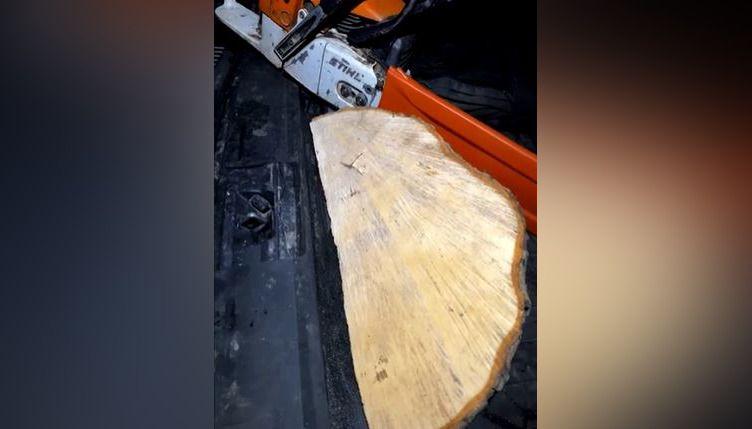
Experts say a wedge of wood came from the tree and was pictured in Daniel Graham's car
They then took a wedge of the trunk home as a trophy and over the following days revelled in the global outrage caused by their mindless actions.
You can see our live coverage of week one of the trial here and week two here, and of the day they were sentenced here.
There is some dispute over the value of the tree, which prosecutors said was between £450,000 and £622,000 but the men's barristers said it was far lower.
The cost of repairing two stones on the wall was put at £1,144.
How did people react at the time?
The toppling of the tree led to an outpouring of anger and astonishment.
The then Hexham Conservative MP Guy Opperman said people he had spoken to were "utterly stunned" and "devastated" at the damage.
He described the sycamore as a "symbol of the North East".
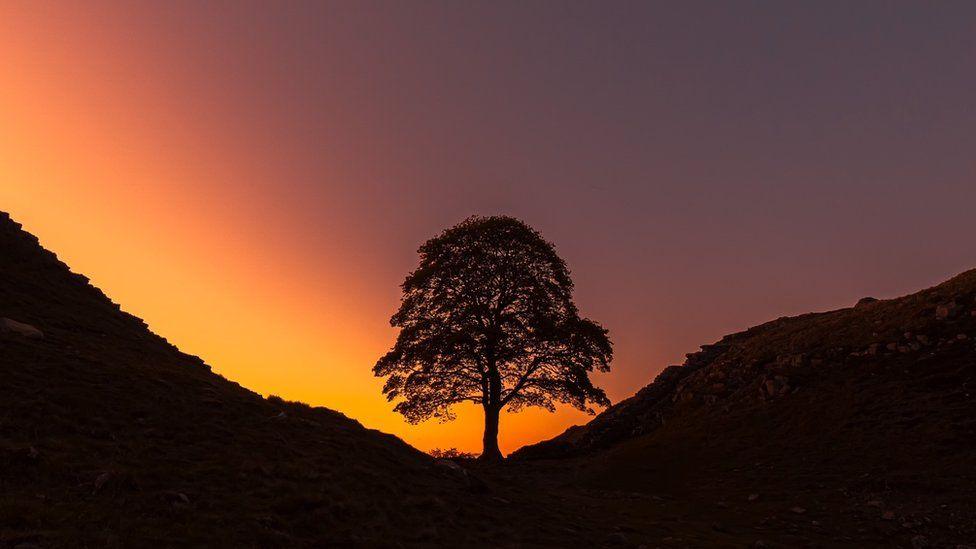
The tree was planted in the late 1800s by landowner John Clayton
Hairy Biker Si King, who grew up in County Durham, posted on social media that a "sentinel of time and elemental spirit of Northumberland" had been "murdered".
People were also keen to share their memories of the tree and why it was so special to them.
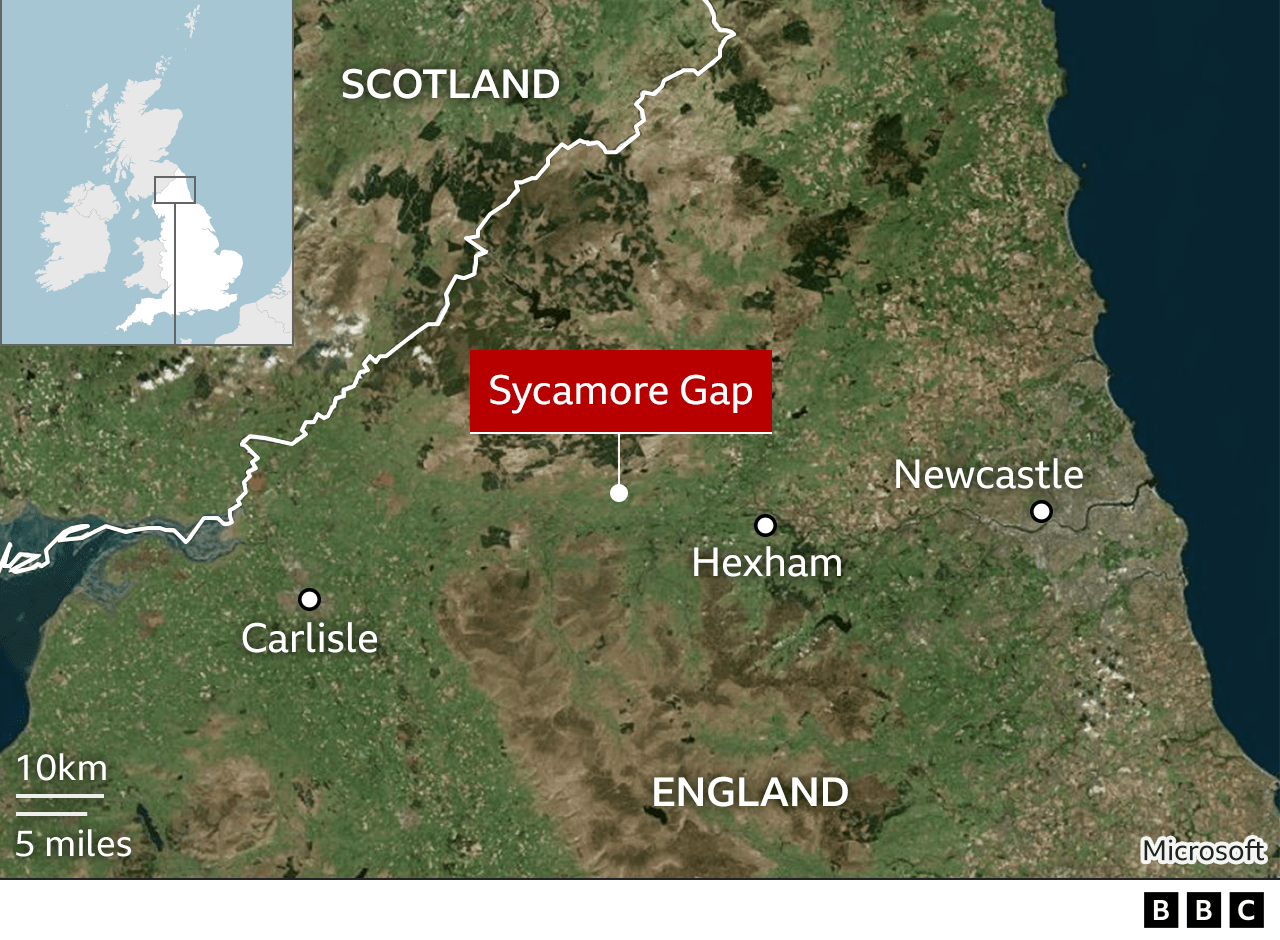
Sycamore Gap is between Carlisle in Cumbria and Hexham in Northumberland
Alice Whysall, from Brampton, Cumbria, believed she may have taken the final photograph of the tree the previous evening, as she stopped there in the rain while on a hike.
She said it was "such an emotional thing to have seen it in its final hours".

The tree has been described as a symbol of the North East
The outpouring of emotion led to impromptu poems about its untimely end and photographs from every angle, and every season, were shared.
It was "a place where truly one could be set free," wrote Harriet Robinson.
What is happening with the tree?
The trunk of the tree was removed on 12 October 2023.
Because it was so big it was cut into large pieces so it could be taken away by crane.
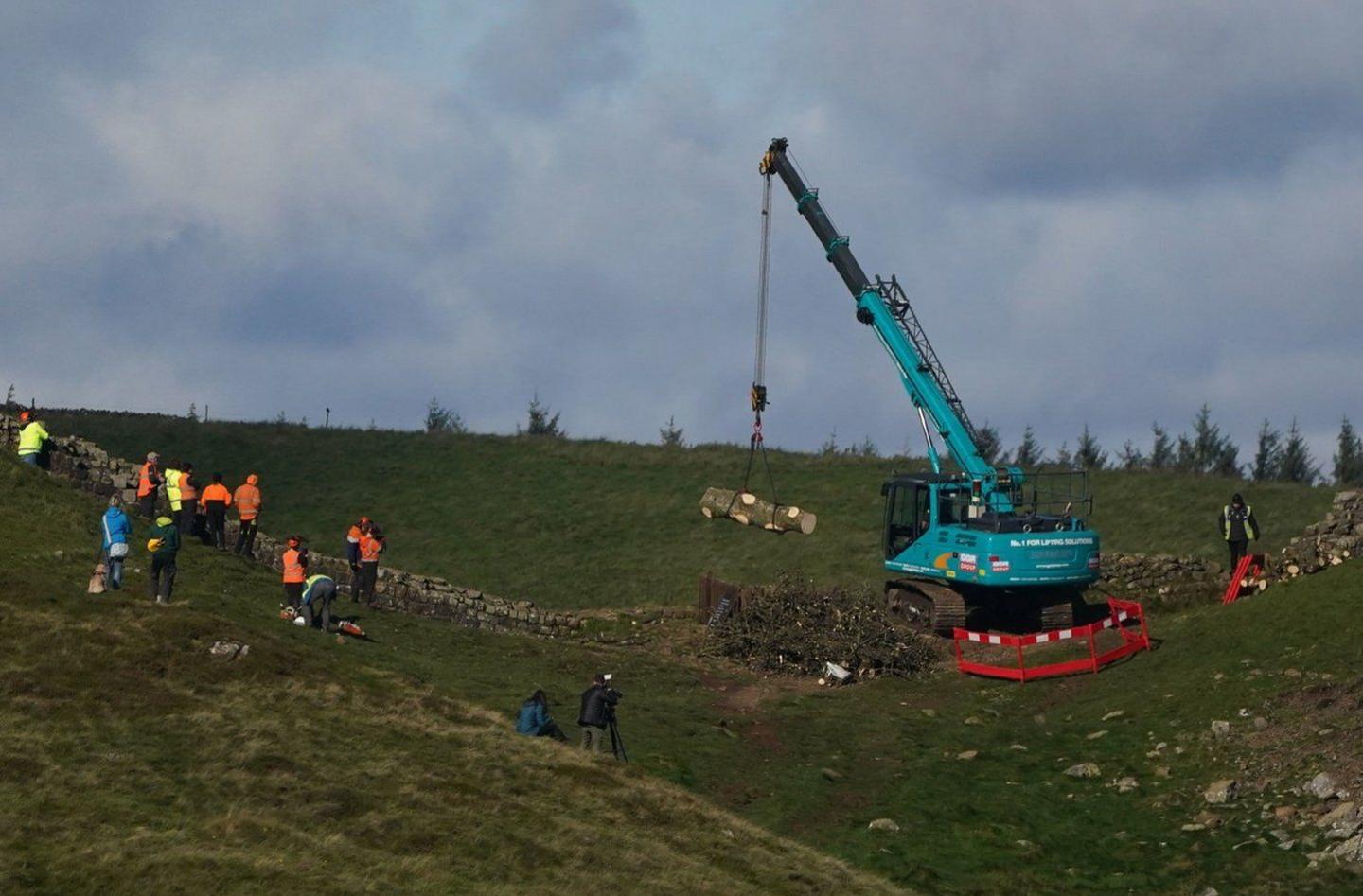
A crane was brought in to remove the tree, which was cut into smaller pieces because of its size
The National Trust has been able to grow saplings from the tree which are being given out to 49 charities and organisations across the UK, one for each foot of the tree's height.
Meanwhile, eight new shoots have emerged from the stump, raising hopes that the original tree will regrow.
It will take up to three years before experts know if this is possible, the trust said.
National Trust manager Andrew Poad said the stump was "healthy" and they might be able to coppice the tree, where new shoots grow from the trunk's base, but it could take up to 200 years to get back to what it once was.
A sapling which was planted nearby in a bid to restore "hope" was removed as the site has Unesco World Heritage status.
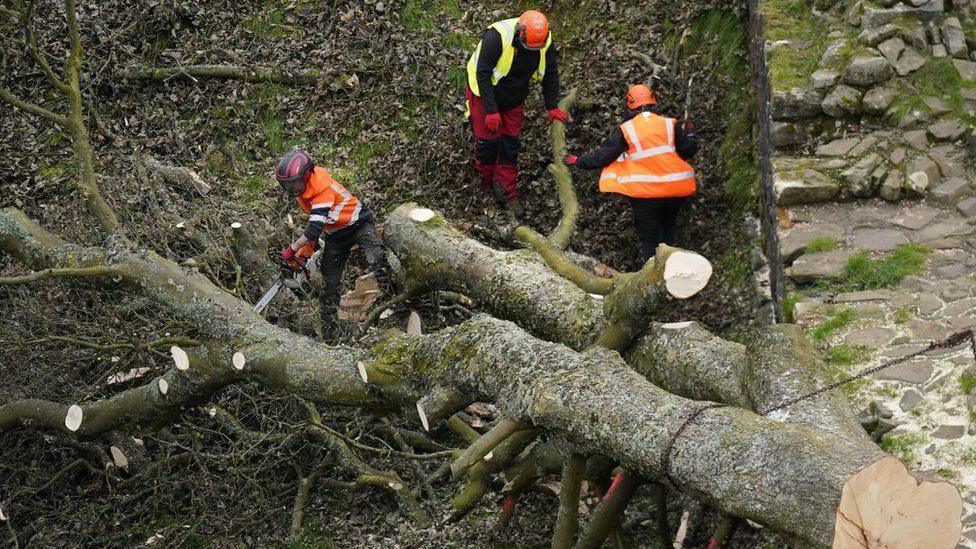
Workers at the site used chainsaws to trim the trunk ahead of it being removed
A large section of the trunk is on public display at The Sill National Landscape Discovery Centre near the site.
And prints were created from a cross-section of the heart-shaped trunk.
Thousands of ideas were also sent to officials, including turning the trunk into benches or sculptures.
Elsewhere, other projects are benefiting from the loss. In North Yorkshire, artist Lucy Pittaway, who painted the Sycamore Gap tree, planted trees at the Swinton Estate for every print copy she sells, hoping a new woodland will revive the area.
The National Trust has advised people to "treat the stump with respect".
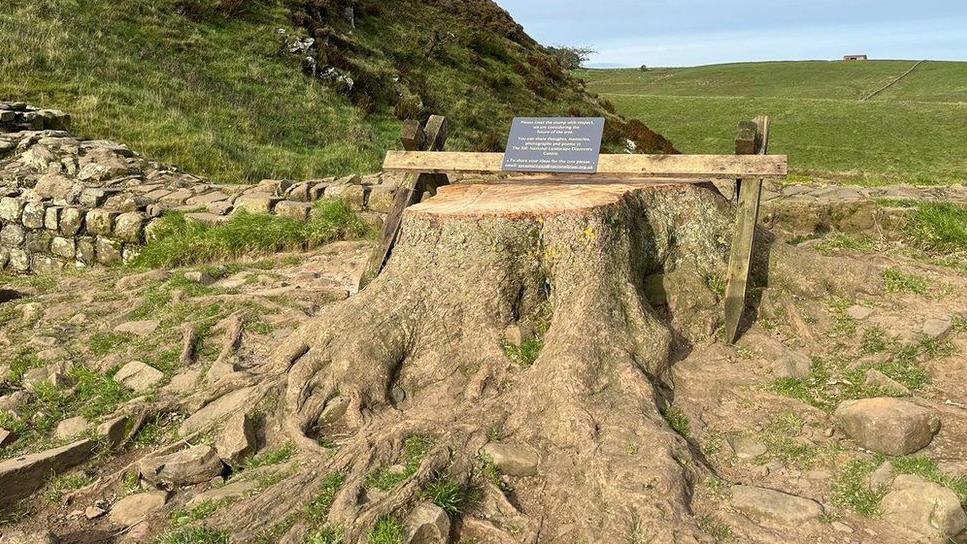
Visitors to the site have been advised by the National Trust to treat the stump with "respect"
Additional reporting by Jo Lonsdale.
Follow BBC North East on X, external, Facebook, external, Nextdoor and Instagram, external.
Get in touch
Do you have a story suggestion for BBC North East & Cumbria?
Related topics
- Published15 July

- Published15 July
